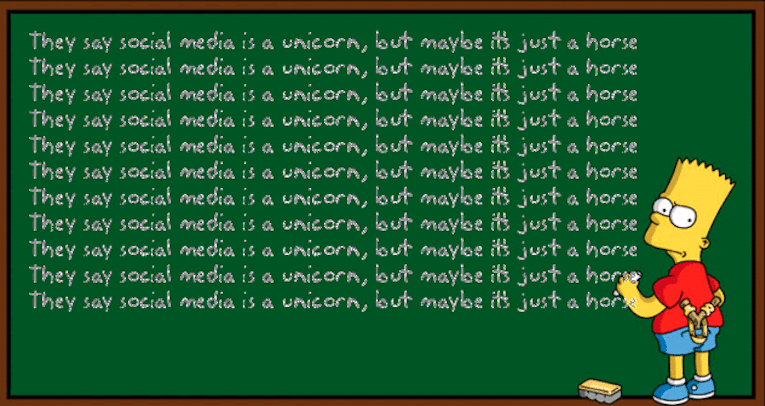I saw the cartoon above online searching for images for another post. Immediately I knew it would one day be a post of its own. Partially because I love Matt Groening’s sense of humor and the incredible diversity of messages he’s put on this chalkboard over the years. (Note, this one is not actually from an episode of “The Simpsons.”)
This image got me thinking about all the ways we look at and talk about social media. Is Snapchat the next big way to sell product or is Facebook Live? Can you really gain return on investment (ROI) from Instagram or Pinterest? Do you reach more via Twitter or YouTube or traditional advertising and media?
So I propose the question: is social media a unicorn? An elusive, magical being with a horn on its head that is both rare and full of magical powers, one that can transport users into a new realm? Is it myth? Or is it actually a horse in a corral with an ice cream cone stuck on its head?
If it’s truly myth, then we should look at social media like we do horses: pretty, strong, swift, full of purpose, but at the end of the day, meant to be in the stable and used for specific purposes that serve the owner. If social media is more like the unicorn, then we should be looking for ways to harness its magic and spread the rainbows that they create to engage more people in magical rainbow content. It might sound silly to make this comparison at all, but stay with me, there is a point here: you have to choose a direction (either the magic or the stable) and feel good about how you harness social media. Here is my case for each:
The case for the unicorn
At its most impressive, social media is an incredible (some may say magical) way to connect with people as they relate to the world: from short videos to conversations that disappear, from images that chronicle lives to romance and dating, from instantaneous to curated. Social media combines diversity and specificity into an amazing opportunity to communicate and affiliate. But as in all forms of content distribution throughout time, social media as platforms are too often overused, under resourced and poorly curated.
When done well, companies and consumers can partner in amazing ways through social media that is unique, specific and engaging. One great example of this is how Netflix treats its social media. The company has developed specific campaigns unique to its audience on each social network channel so that who they are targeting on Facebook (and the content they are putting up) is different than what they are doing on Vine. They are all about celebrating the diversity of their audience and their platforms. It takes a large team to pull off, but they do a very good job of it. More team members and more content means this approach doesn’t come cheap, but take a look at the top 15 social media networks and you will see it represents billions of unique users every month. This is billions of opportunities to reach an audience that glosses over traditional media/brand engagement.
The magic of social media is not in the content on each network, it’s in treating each person as a unique opportunity for engagement in a language (read: the format of their favorite platform) they love. When we try to force-feed content into what we want versus what each medium/customer expects, we fail. When we try to distribute at our content schedule versus the frequency of each medium, we fail. When we slap a brand into content and think that “advertorial” works equally well in each, we don’t recognize the promise each network makes with those that love its uniqueness and again, we fail. And when we fail, the unicorn is just a mythic creature that nobody believes.
Not sure you agree? Look at Oreo. They have an iconic product that you’d think cannot be pushed out in unique ways that are different in engagement on social than they are in traditional mediums. But they have looked at their audiences on each platform and created unique content for them. Vine videos (as silly as they sound) included. When you are a known brand but you take that time, you capture millions of unique social media followers. Think about that: millions of people are reviewing content on a cookie monthly because what they create is engaging. Does it up their value and their engagement? Absolutely. More so than if they stayed with traditional marketing pieces on social media? If you believe in the unicorn, the answer is yes.
Also on StartupNation.com: Fresh Perspective – Fish the Pocket, Not the Current
The case for the horse
Many companies (and in media, many networks and digital outlets) take their primary property and cut it up into many forms for distribution across different mediums. In this version, social media is indeed a horse. Each form of distribution requires a different breed (for speed, for heavy lifting, etc.), but the horses themselves are not the focus. What is primary for success with the horse is having a large stable that can support whatever content you are putting out.
A good example of this is the strategy at GrubHub, one which is focused on enticing people into ordering through its delivery service. They are very visual because they know that regardless of medium, people need to eat and it is proven that if you see food that makes you salivate, you are more apt to become hungry. GrubHub puts the same basic content on every site, knowing they can get the same reaction. Their horses all work, some harder than others. But again, same basic content.
While financially and from an “ease of use” perspective, this model makes sense, what is lost here (if you don’t have the power of salvation like our example above) is the power of engagement that each social media network holds. It becomes a numbers game with companies making the bet that what appeals to them appeals to those that engage in their product. And truth be told, the case for the horse is strong. This is the way that much of corporate America has worked with social media to date. Sure, they all have social media teams that look for unique interaction, but the overall imagery and content is generated, not by what is native to each platform, but by what is native to the brand. Unless you are as laser focused as GrubHub, you are throwing the net hoping you’ll see return.
The case for reverse engineering
Over the next few months, I’m going to be pushing this idea over and over: content works best when it is reverse engineered to fit the end goals of individual consumers. The idea that what we already do is good enough to engage an ever widening, ever specifying audience no longer holds true. Many of the top brands understand this concept and have brought the development of content in-house via content studios to approach their audiences in new, unique and platform-specific ways (that their agencies and PR/marketing firms cannot). Here’s a good way to think of the difference between the traditional “horse” approach and a reverse engineered approach that unlocks the “unicorn” potential:

While this graphic is simplistic, it is also accurate. As a community, creators believe that content drives engagement. “If you build it, they will come.” I am all for strong content that tells a story and grabs the attention of the end user. But when content is at the top of the conversation, you are trying to put your “peg” into the distribution holes. The assumption that they will come might be true, but the better question is, “If you build it, will they engage”?
Unlike pure entertainment programming, brand-based content must have that question answered first: how you want people to engage and THEN work backwards into content:
Understand what you are focused on for engagement (the end goal), figure out which of your customers are targets for that goal (if you are big enough to have a diverse customer base this means you stop with a “one piece hits all” mentality), then you think about which networks work best for engagement with that audience, and finally what content works best for that platform and objective. You don’t say, “I have the perfect idea for a Vine video series,” you let the goal determine what content works on Vine. That is reverse engineered content.
When this is done well, the platforms can be magical portals of potential, unicorns that truly inspire and connect with the end user. The content we create can be both entertaining and engaging. Invest in its development and you succeed in stronger engagement. Invest in the traditional approach and you might spend less, but you will also realize a much lesser return on investment.
But just as only a few ever find the elusive unicorn, ordinary content teams cannot shift gears overnight. They need guidance and focus. They need to engage themselves in a new process, one that helps them rethink engagement and development. For most companies, the barrier to entry seems too high to take on this reverse engineered approach. They see that Coca-Cola, Marriott and their Fortune 200 brethren are in the content studio world but they don’t have the same opportunity.
Final thought: reverse engineered content (in-house content studios) should not be limited to the biggest companies. Every business, every brand deserves to have the same outcomes and the same opportunities. I am excited to speak with you to determine where you are in this content world; to help you do more with your content by focusing differently. Feel free to reach out: [email protected]. This is your time to choose the horse or the unicorn. This is your time to become the magic that you know you are! I can’t wait to see where you go!
_______________________________
Patrick Jager is CEO of strategic advisory firm CORE Innovation Group and a thought leader in media, communications and business development.






